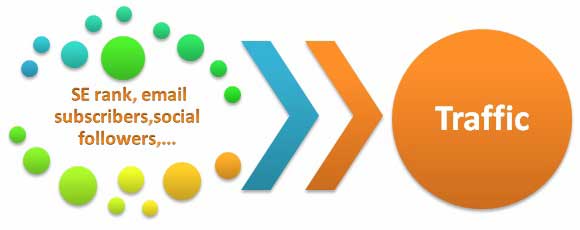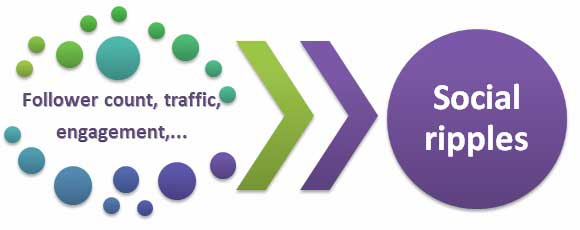If you do content marketing, you probably want it to help increase sales in the long run. However, the tricky part is that usually there is a time-and-space gap between a piece of content you publish and a closed sale.
So, what metrics can marketers track to make sure their content strategy is headed in the right direction?
1. Traffic: Down the Black Hole
Launching a content marketing campaign is a little bit like setting up a sales funnel: Your task is to capture as many people with your content as you can, and to make sure they make it to the end of the funnel.
So, the first metric to measure in this respect would be the sheer number of people you managed to get into the "funnel"—that is, traffic to the page where your content is located.

In turn, the amount of traffic you manage to drive to your content depends, in part, on...
- The page's search engine rank
- The size of your email subscription base
- The number of social followers you have
- A host of other factors
How to Measure Traffic
Measuring raw traffic numbers is not that hard. It gets trickier later, when you have to go deeper into the data, but not at this point yet.
If you publish the content piece on your own site, you can see pageviews in Google Analytics. If it's published elsewhere, you can't see how many people viewed the page, but you can track referral traffic, since your content likely links to your site.
Apart from Google Analytics, there are other free and paid Web analytics tools that can let you know the same (for example, free analytics in WordPress).
If there is not much traffic coming to the page where your content is published, look into the "supporting" factors: search engine rankings, email titles, the way you announce the content piece to your social followers (also timing is important here).
In my own experience, to get bigger reach, you should...
- Optimize your content for the search engines (use appropriate keywords, encourage others to link to it).
- Aim for publisher platforms with a decent list of subscribers and social followers.
- Build your own extensive email list and social following.
2. Engagement: Now We're Talking
Engagement is the next performance indicator you'd like to measure after you see how many visitors have been drawn to your content.
What's engagement? It's the length and quality of people's interaction with your content. It normally translates into bounce rates, time on site, abandonment rates, comments, social shares, etc.

What drives engagement? Why are some content pieces read and re-read, shared, and re-shared, while others are just given a quick look-through? Here are some things to pay attention to:
- Content relevancy is key.
- Design and layout are important.
- Content "stickiness" (its ability to grab and hold attention) is important as well.
How to Measure Engagement
If you use Google Analytics, look into...
- Bounce rates
- Average visit duration
- Pages/visit, etc.
Sometimes, despite sufficient traffic, there isn't much engagement going on, which could be for several reasons:
- Something puts people off (too many ads on the page, small print, etc.).
- Your content is poorly targeted.
- You have too much content, more than required (so, people don't bother reading the whole thing).
- Your content is poorly structured (it should be obvious to content consumers where they should look first, second, etc.).
- Your content lacks substance (to me, any piece of content should have something substantial to it: something helpful, new, entertaining, insightful, inspiring—something in it that makes it worth reading).
Some click-tracking tools (such as MouseFlow and CrazyEgg) actually let you see what users do on your site. You can use such software to get an idea of what may be causing people to stop interacting with your content.
3. Social shares: how much ripple can you produce?
Another measure of content success is the number of Facebook, Twitter, Google+, and other shares it receives.

Top underlying metrics here would be traffic and engagement (the last two in the image). However, sometimes people just bookmark or retweet your post without actually reading it, in hopes of giving it a read later. In that case, you'll see the number of shares, but it doesn't necessarily mean those people engaged with your post.
How to Measure Social Impact
A quick way would be to look at the number of likes, tweets, and other shares on the social buttons next to your content (and you should have them there).

However, they may not account for all the shares.
Here's where social analytics tools can help. Software such as Simply Measured and Sysomos lets you get deeper insight into how your content is shared across social networks, who shares it, etc.
4. Backlinks: Will Your Content Stand the Test of Time?
Normally, people link to content because they find it useful, authoritative (they want to reference it), interesting, funny, etc. So, Backlinks (links back to your content) is another performance indicator of your content's success.

Specialists have analyzed what makes people link to content, and they have discovered that usually it's certain hooks:
- Applicability. If it's really useful and can be used in the future, people will link to it.
- Authority. If it's a piece of writing by a well-known and reputable author, people would want to reference it.
- Ego. The content makes one proud of oneself (known as the "ego" hook).
- Fun. Hilarious content is just about the most linked-to content.
- Controversy. If your content is not run-of-the-mill and makes people think and discuss, it's likely to inspire linking.
How to Measure Backlinks
Before I proceed, let's clarify why you should care about backlinks at all. Well, for two reasons: because they drive traffic, and because they build website authority with Google.
At the same time, it's also important that your links come from legitimate, reputable sites, because links from crappy sites (with no traffic, no Google PageRank) are likely to be frowned upon by the search engines and won't bring you much traffic anyway.
You can see who is linking to your content either in Google Webmaster Tools or in Google Analytics. Both are free services. However, to really see what those backlinks are worth (how legit the domains they're coming from are), you'd need tools like our SEO SpyGlass that report a larger variety of backlink metrics.
By the way, I use SpyGlass for a very specific type of analysis—to check how my guest articles perform. It's integrated with Google Analytics, which lets me see how many visitors I got form guest posts, how many social shares I got, the PageRank of the page where my guest post is located, etc.
5. Conversion Rates: The Utmost Metric
If the ball almost hits the wicket but eventually misses it, you get no points. The same is true of content marketing: In the end, if your overall strategy is to be successful, you content should drive conversions.

Conversions depend on whether the visitor understands what action he/she is expected to take while engaging with your content.
To make that clear for the reader, marketers use a call to action. It can be as obvious as a big orange button that says "Press here" or as indirect as a contextual link. But it has to be there.
Another factor that affects conversions in a big way is whether the content you market is relevant to the action one is expected to take to convert. For example, if your goal is to make people sign up for a newsletter on your travel blog, it's probably not wise to market a piece of content that has a cheesecake recipe.
How to Measure Conversions
Again, Google Analytics is your friend here. The metrics you'd want to look at are these:
- Goal Completions and Total Abandonment Rates
- Goal Flow
- Visitor Flow
If you'd like to know how to set up Goals in Google Analytics, check out this section in Google Analytics Support. Avinash Kaushik (the Google Analytics guru) has an super-helpful post on how to estimate what your Goal is worth (in dollars). And, if you are looking to better understand Visitor Flow and Goal flow, here is another quick tutorial to help you.
Conclusion
To avoid the spray-and-pray approach to content marketing, it's important to measure as many of its key performance indicators as you can. Doing so will allow you to correctly align your content creation and distribution efforts with your end goal and make the most of your campaign.





